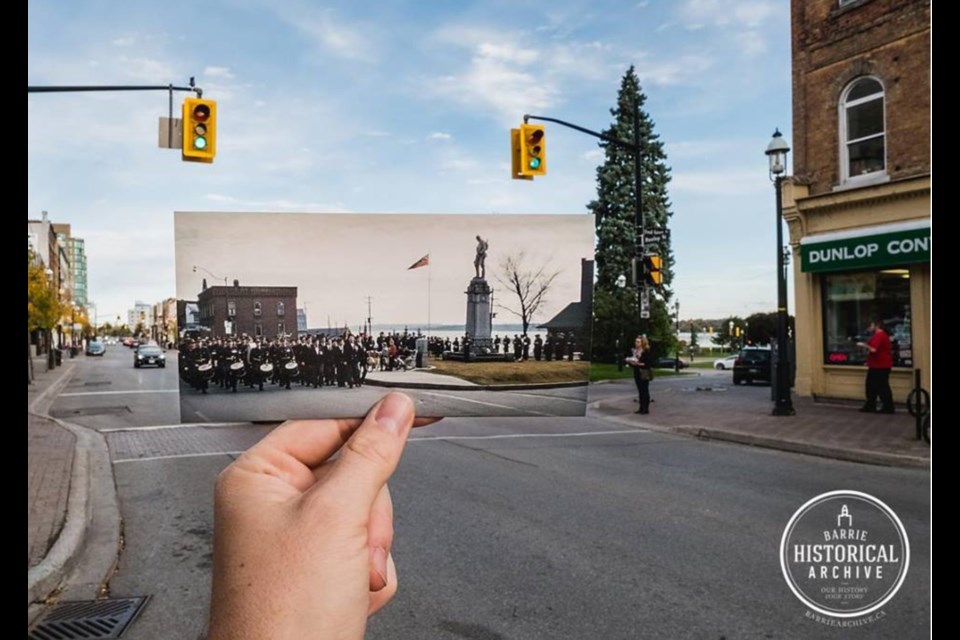This ongoing series from Barrie Historical Archive curator Deb Exel shows old photos from the collection and one from the present day, as well as the story behind them.
Barrie Cenotaph
The place where we gather, whether for Remembrance Day or other community events, has been known by several names.
That area at the foot of Owen Street has been called Station Gore, Memorial Square, Post Office or Fred Grant Square, and now Memorial Square and Meridian Place.
The site was first defined when a rail line was extended around the bay from Allandale to Barrie in 1865. A terminal and sheds were built at the foot of Owen Street, near the town wharf, and at the southernmost end of the Nine Mile Portage. To accommodate the new track bed, fill was used to extend the shoreline. The Station Gore, as it was called at that time, was a busy area, not only as a transportation hub, but as a gathering place even then.
Barrie’s first federal building was constructed on Station Gore in 1884. It was a permanent home for the post office, its inspectors and the customs house, designed by Barrie architect Thomas Kennedy, in a surprising exception to the rule of using a government architect. It was a striking new addition to the downtown.
Following the First World War, plans were made to honour fallen soldiers from Barrie, as well as Vespra and Innisfil townships, with a monument. The site selected for the monument was Station Gore.
With the design approved, the McIntosh Granite Company of Toronto set to work. Its project would be 24 feet and six inches in height total, the bottom step of the 15-foot-and-six-inch Stanstead granite pedestal would be 10 feet and six inches square and the Barre granite statue itself, nine feet tall.
The stirring monument’s design represents a Canadian soldier leaving France at the end of the war, but not before laying a wreath on the cross marking the grave of a comrade who would never see home again. At the foot of the soldier are broken gun fragments.
The crests of two Simcoe County military units — the 157th and 177th Battalions — along with the names of the fallen area men were carved on the monument.
Later, slabs were added on each side of the monument, inscribed with the names of soldiers lost in the Second World War, Korean War and Afghanistan.
The soldiers’ memorial was dedicated in June 1922. Mayor John Little proclaimed the day, between the hours of 1 and 3 p.m., to be a holiday and for businesses to be closed.
The public in general was invited to attend the event, and relatives of all the soldiers named on the monument were seated in a reserved area near the King Block. The Barrie Band opened the program with O Canada and the Simcoe Foresters formed the guard of honour.
At the four corners of the monument, uniformed veterans with reversed rifles stood: R.R. McEwan, 16th Battalion, Canadian Scottish; Alfred Thorogood, 15th Battalion; James McLeod of HMS Emperor of India; and Victor Kilgour of the 2nd Canadian Infantry.
During the ceremony, his Col. Henry Cockshutt, lieutenant-governor of Ontario, and his official secretary, Col. Alexander Fraser, both in uniform, approached the monument, which was draped with an enormous Union Jack flag.
With the pull of a string, the statue and the names of the men honoured were revealed, accompanied by the words of the lieutenant-governor: “To the Glory of God and in honoured memory of the men of these communities who, during the Great War 1914-1918, gave their lives for God, for King and country; for loved ones, Home and Empire, for the sacred cause of justice and the freedom of the world, I unveil this monument.”
The cenotaph has been the focal point of Memorial Square ever since it was erected, and a place of reverence and reflection every Remembrance Day. Newcomers to the city, or those not old enough to remember, would often question why the monument was off to the side of the gore, not knowing an imposing, sandstone building once stood in the centre of the square.
The post office that once commanded the square was demolished in 1958, leaving the handsome landmark seemingly adrift.
In 2017, the statue was moved to the centre of Memorial Square, creating the symmetry the eye craves and making the glorious cenotaph the centrepiece it deserves to be.
The Barrie Cenotaph is listed on the Municipal Heritage Register for its cultural heritage value.



